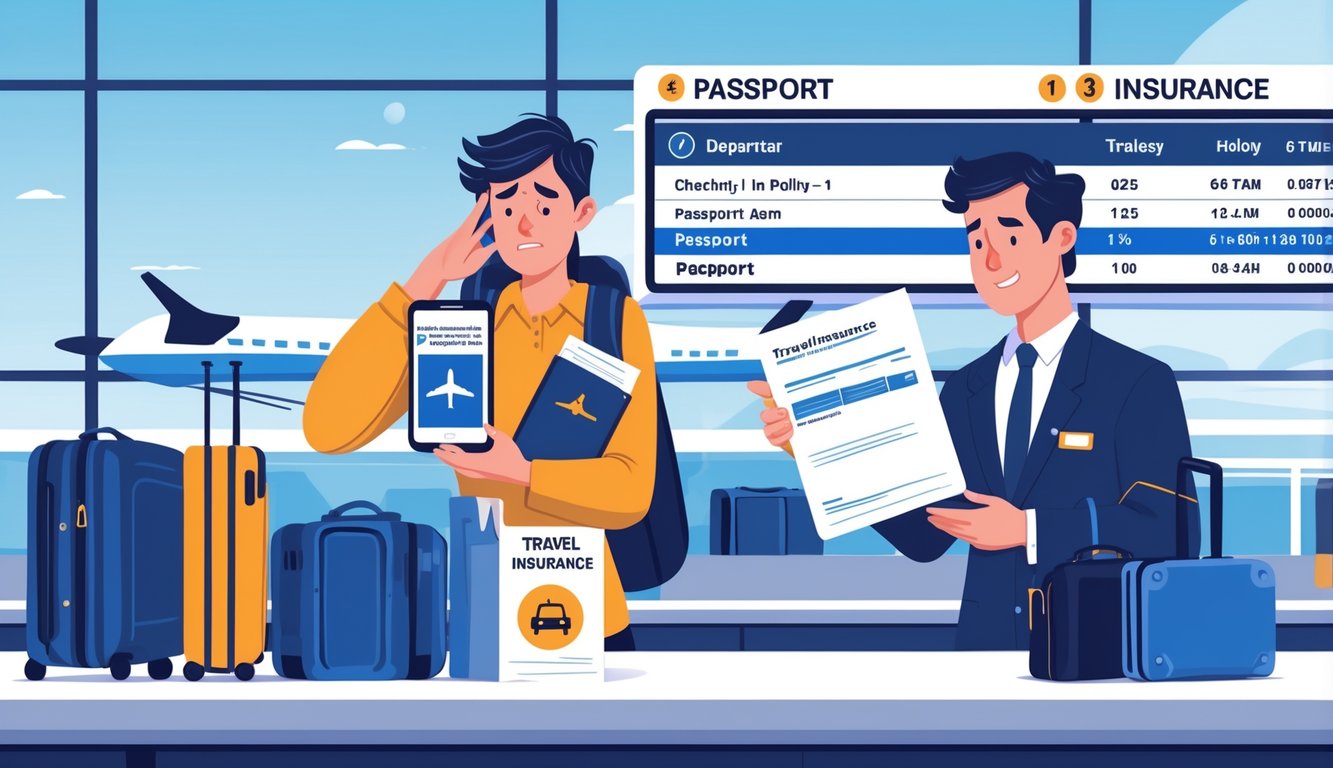
Extra Coverage Features Travelers Might Overlook
Why does everyone obsess over packing cubes but forget about “baggage coverage”? Makes no sense. Some decent policies just skip over the trip add-ons—like, sure, I’ll plan for my suitcase to teleport itself into oblivion. Most plans I’ve seen barely mention this stuff.
Baggage Coverage and Delays
Last August, I’m juggling chargers, sweating through security, and all I’m thinking is—will my backpack even make it? I’ve been burned so many times by baggage delays, exclusions, or laughable reimbursement limits. Policies claim they’ll cover essentials, but what does that even mean? Deodorant and a cheap t-shirt? Forget your laptop or jewelry unless you read every word of the fine print.
Payouts max out so fast—$500, $1,500 if you’re lucky—and then they carve out “valuable items” with all these exceptions. And that’s if you even remember to save those crumpled airport receipts. I asked people on the road, and more than half had no clue if their bags were actually covered.
Table: Typical Baggage Delay Coverage
| Feature | Common Limit | Not Covered (Sometimes) |
|---|---|---|
| Essential items | $100-$200/day | Electronics, cash, fine jewelry |
| Max reimbursement | $500-$1,500 | Antiques, rare collectibles |
| Delay starts after | 12-24 hours | N/A |
Rental Car and Adventure Travel Add-Ons
Ever get stuck at a rental counter abroad and they hand you a waiver form written in what looks like code? Rental car coverage is basically an afterthought—most basic plans just ignore it. If the rental company’s policy reads like IKEA instructions, you better check for “collision damage waiver” (CDW) or “loss damage waiver” (LDW) in your insurance.
Some credit cards throw in CDW, but yeah, the loopholes are huge. Go off-road or do anything remotely “adventurous” and—surprise!—you’re not covered. Saw it happen last spring: guy thought his Croatian jet ski was insured. Nope. Experts keep saying adventure travel and extreme stuff almost never come standard, no matter how cool the brochure looks.
Even when you get a rental car add-on, it’s usually capped way below what you could actually owe, and they’ll just say “no” to tire, window, or undercarriage damage. Wild how “comprehensive” means whatever they want it to mean.
Travel Delays and Trip Disruptions
You ever sit in an airport staring at those “delayed” signs and wonder if your insurance even covers this? Policies sound amazing—until your layover turns into an overnight campout by the vending machines, and suddenly you’re footing the bill for hotels and food.
Every insurer defines “covered travel delay” differently. Some say four hours, some say twelve, and credit card protections? Sometimes they don’t kick in until you’ve basically missed your next vacation. What counts as a “covered reason” is a riddle—mechanical failure? Maybe. Crew sick? Who knows. Weather, strikes, traffic—every clause is a trap.
Compensation? Don’t get me started. Daily and overall caps are stingy, like $100 a day, and you need every receipt for every snack. My friend missed a cruise connection, filed everything, and got back half his hotel costs after six emails. Miss the 30-day filing window? Too bad. Lose your boarding pass? Good luck.
How to Choose the Right Travel Insurance Provider
Funny how I’ll spend an hour looking for a lost charging cable but forget to check travel insurance until I’m at the gate. If I ever get stuck again, here’s what I’ll try to remember: coverage changes constantly, some companies have okay annual plans, and exclusions hide everywhere.
Comparing Coverage Options
Picture me, three browser tabs open: Allianz (because they’re old), AIG Travel Guard flashing a $259 annual deal, and some site promising customization I can’t figure out. Coverage options are endless—trip cancellation, medical emergencies (what if I eat bad oysters?), “CFAR” (cancel-for-any-reason), but baggage delay? You’ll find that in the fine print, buried deep.
Random fact: some policies don’t cover pandemics. I booked a nonrefundable guesthouse in Hoi An, then found out public health emergencies are never covered. Makes sense, right? Sometimes they mention sports equipment, jewelry, or pets, but it’s never consistent. Comparing means slogging through ugly charts and PDFs while half-packing. And “comprehensive” means nothing—what’s covered in Portugal could be excluded in Peru.
Evaluating Travel Insurance Providers
Every provider swears their claims process is “seamless,” but then you Google them and—oh look, forums full of angry people whose appendicitis claims got denied. Consumer reviews are a mess. I look for real 24/7 support and, if I can find it, U.S.-based customer service. You can buy insurance from comparison sites, but who picks up when you’re in a French ER? Seriously.
I once went with a slick app for the instant quote—turned out, you could only submit claims by fax. All the “best insurer” lists change every year, so I check new roundups from places like NerdWallet before I pay. I care about how long they’ve been in business, their BBB rating, and if they cover both single and multi-trip plans.
Understanding Policy Limits and Exclusions
Limits and exclusions are a nightmare. It’s like sorting socks in the dark, except every sock might have a $10,000 cap and “pre-existing conditions” are just missing. Even the priciest plan has scary limits—evacuation max (sometimes $500,000, sometimes $50,000, what’s the difference?), baggage loss, rental car, tiny daily “inconvenience” caps.
And the exclusions—yikes. Pregnancy, civil unrest, bad weather, “acts of God” (that’s a real phrase in policies), all might be out. One insurer denied my lost camera claim because “electronics exclusions applied to checked bags.” A lawyer once told me concert tickets don’t count under “entertainment clauses.” I dig through legalese for pre-existing waivers, and the “lookback period” is 60, 90 days—totally random. TouristSecrets does a decent job pointing out that every little exclusion can ruin your day, even if you’ve never stubbed your toe in flip flops.
Making a Claim: What to Expect
Nobody thinks about claim timelines until they’re sunburned and digging through a pile of receipts. Trip insurance feels optional—until your “non-refundable” villa turns into a money pit. With no clear process, all that “peace of mind” stuff? Gone. Suddenly I’m searching my inbox for a policy I barely remember buying.
The Claims Process Step by Step
Forget the commercials. There’s no soothing voice or fast approval. You get a claim number and maybe a callback if you’re lucky. Travelers Insurance says you’ll get contact info, but it’s mostly you trying not to lose your mind while figuring out how to “mitigate further damage”—like, what does that even mean when you missed a kayak tour or your river cruise got hijacked by otters? I once spent forty minutes trying to figure out if “reasonable attempts to recover costs” meant begging Air France in three languages.
You’re supposed to start your claim the second you realize you’re out money, even if airport Wi-Fi is terrible. Time limits are random and strict; Allianz says miss them and you’re out, no matter how sad your story is. If you want to get paid, you call, you email, you upload every document twice—because they’ll ask again—and it still feels like nobody believes you. Don’t exaggerate, don’t wait. Just keep refreshing the portal. One adjuster told me, “Clarity and speed get you paid.” Sure. I’m still waiting.
Documenting Your Trip and Expenses
People act like keeping receipts is enough. It’s not. Every claim wants a timeline more detailed than your group chat, with proof for every deposit, refund denial, and boarding pass, preferably as a color PDF. After four failed claims and one grudging payout, I now screenshot everything and text myself the claim number (since Wi-Fi always fails when you need it).
You’ll need policy numbers, original itineraries, receipts for everything, written proof of any denials—Travelers Insurance specifically wants you to prevent further damage, which basically means don’t just give up. If you spent money on non-refundable stuff, you need itemized documentation, with dates, vendor info, and proof you tried to get a refund.
The people who actually get paid? They keep a Google Drive folder with scans of everything and up-to-date airline and hotel contacts. Is it foolproof? Nope. But my last claim only took four emails and was the fastest payout I’ve ever seen. First time I tried? I sent phone screenshots, half in Spanish, and got a denial so generic I wasn’t sure it was for me. No matter what, admin staff will never believe you spent $300 on snorkeling unless you’ve got a digital paper trail that makes their job idiot-proof.



